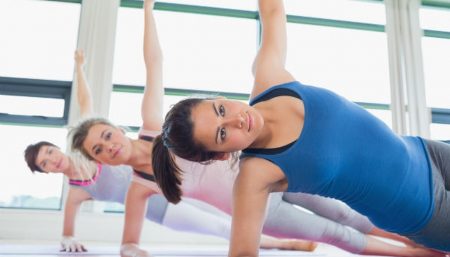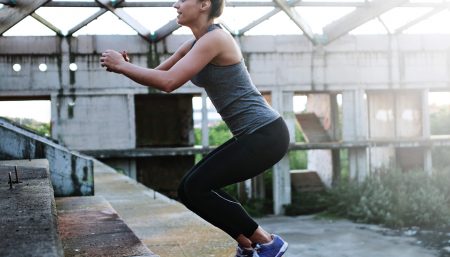Plyometric training is specific work to enhance explosive power. In other words, it involves a lot of jumping. Plyometric training is used for sports that require short bursts of power such as tennis, basketball, or skiing, but it’s also a good exercise for anyone who wants to increase her power.

Here are a few Plyometric exercises to add to your routine. Also, make sure to warm up adequately andstretch before you begin. Plyometric training should progress gradually from lower intensity to higher intensity drills, especially for individuals who lack a significant strength training background.
Note: Plyometrics is a high-impact activity, so if you have any joint trouble or back pain, give it a miss.
Plyometric Tips
- Before a vertical jump, crouch to a point where your knees reach a 90-degree angle
- Use your arms. The inertia of swinging your arms up as you jump will help pull the rest of your body up
- The faster you are moving before the jump, the higher you can jump. This is why high jumpers get a running start – to jump much higher than they could from standing still
- Think about landing with your entire body, not just your feet. The shock of landing is not absorbed by the foot alone; instead it’s a combination of the ankle, knee, and hip joints working together to absorb the shock of landing
- Pretend that the ground is hot, and you want to jump back up quickly
- Land quietly. You shouldn’t hear a loud slapping noise when your feet hit the ground
Bounds

Start off by jogging for a few paces. Then push off with your left foot and bring the left leg forward, with knee bent and thigh parallel to the ground. At the same time, reach forward with your right arm. As your left leg comes through, your right leg extends back and remains extended for the duration of the push-off. Hold this extended stride for a moment; then land on your left foot.
Then, the right leg comes through to a forward bent position, the left arm reaches forward, and the left leg extends backward as you continue on the other side. Make each stride long, and try to cover as much distance as possible. You should land on the sole of your foot and immediately take off again. Keep the foot touch-down time as short as possible. Try two or three bounds.
Don’t try too many bounds in one go. Quality is much more important than quantity here, especially because these exercises are to build strength and power rather than endurance.
Start off by doing one; then work up to doing a maximum of five per set for two or three sets. Always rest between sets.
Single leg hops
Stand on one leg. Push off with the leg you are standing on and jump forward, landing on the same leg. Use a forceful swing of the opposite leg to increase the length of the jump, but aim primarily for height. Land mostly on the ball of your foot, and immediately take off again.
Keep your foot on the ground for the shortest time possible. Try a few times on one side; then try the other. Keep your body vertical and straight. When you start, a straight leg is okay. As you get better, try to pull the heel towards your bottom during the jump.
Bunny hops
Stand with your feet shoulder-width apart. Lower into a squat position and jump as far forward as possible. Land mostly on the balls of both feet. Try to keep your body vertical and straight, and don’t let your knees move apart or to either side. Use quick double-arm swings and keep landings short.
Tuck jumps
From a standing position, jump up and try to grab both knees up by your chest; this is the ultimate goal, so don’t worry if you can’t do it right away. It’s very challenging.
Return to the starting position, landing mostly on the balls of the feet. Spring up as quickly as you can. Again, try to touch down with your feet very briefly before trying again.

Summary
- Jumping jacks are a quick way to up your heart rate and tone the muscles. Double check your form to make sure you get the most from your workout.
- Grab a skipping rope and act like a child! Skipping is a fun way to get in shape. Adding some new moves can make it more exciting.
- Ready to try a squat thrust? If not, check out a few modified versions to help you ease into it.
- Loosen up and stay mobile and strong with the all-powerful windmill move.
- Jump training, or Plyometrics, can increase your strength and power.
Related Links
- At-home Gravity Workout: to build muscle & balance
- Strategy for building muscle mass and muscle density
- Healing Your Muscles
- Increasing overall Flexibility
- Skipping to Good Health
Disclaimer
The Content is not intended to be a substitute for professional medical advice, diagnosis, or treatment. Always seek the advice of your physician or other qualified health provider with any questions you may have regarding a medical condition.



